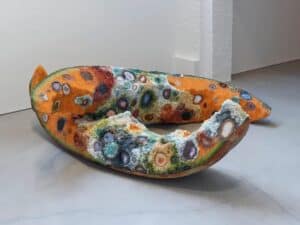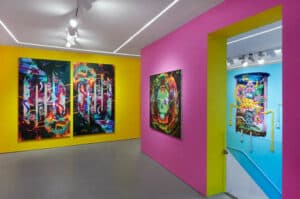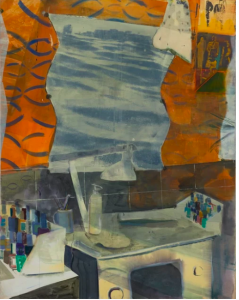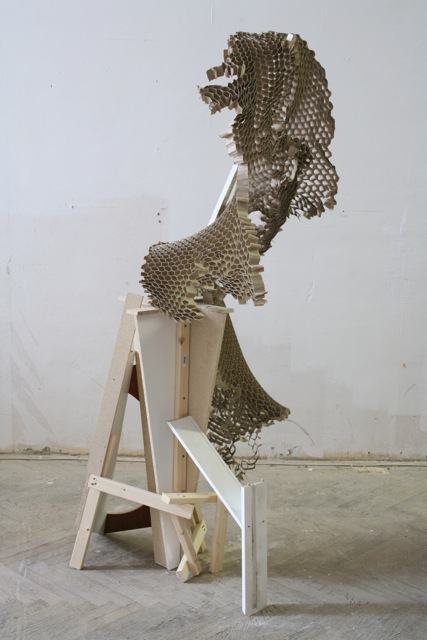
Image:Fabian Seiz Atlas 2009 Wood, cardboard 84 x 56 x 180 cm / 33 x 22 x 71 inches
6th May – 24th June 2011
The debut show of Viennese sculptor Fabian Seiz.
As human consciousness experiences space in the presence of time, the fixing of space in an artwork can be read as an artist’s attempt to freeze time, thereby transcending the limits of his or her own ephemeral existence. The sculptures in Fabian Seiz’s exhibition French Park / I Was Here, are in this sense a response to humanity’s enduring need to leave behind a sign, a mark, a footprint – a record of its presence. Seiz scratches “I was here” in the bitumen covered ground of the upstairs gallery. He adopts this familiar epithet to extend his own presence in the space for the duration of the exhibition – thus implicating the viewer in this process as we leave our own mark on his work and the exhibition itself, through our footprints on the floor.
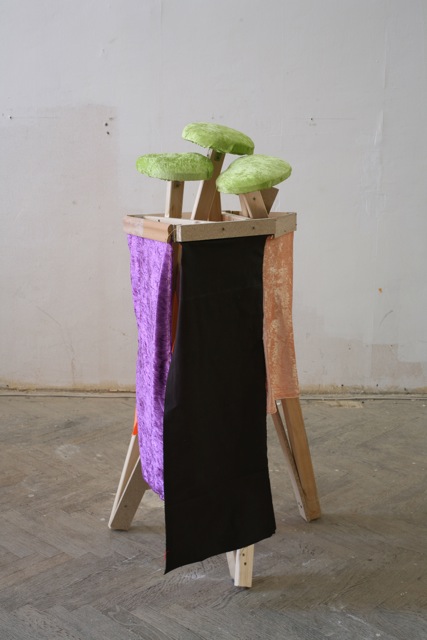
Image:Fabian Seiz Hofnarr 2009 Wood, fabric 60 x 65 x 120 cm / 23.5 x 25.5 x 47 inches
Throughout history different epochs have worked to extend the artist’s transient scope beyond the boundaries of his or her own existence. Just like the self-portrait and other cultural achievements, garden design has reflected changes in the ways we experience and define ourselves. In the 17th century a new mode of extending one’s reach emerged when the central perspective – whose vanishing lines in the Renaissance originally served the purpose of facilitating the representation of space in painting – was transformed into the pictorial landscape of the French Park, or Jardin à la Française.
Seen from a well-defined, privileged vantage point, vanishing lines would converge in infinity within one’s natural surroundings. Standing in this exhibition amongst Seiz’s sculptures, the viewer’s gaze travels down and through this troop of assembled characters – beyond the confines of space.

Image:Fabian Seiz On / Off II 2010 Wood, plastic, rubber 69 x 60 x 133 cm / 27 x 23.5 x 52.5 inches
Yet despite this heightened sense of awareness within one’s own environment, the French Park also stands as an emblem of humanity’s attempt to control and manipulate nature to its own desires. Fabian Seiz’s interest lies in humanity’s constant search for orientation – our resort to all kinds of philosophical and scientific abstractions, each with its own language, logic, and imagery – as a means of finding explanation. The various works in this exhibition convey the park’s measured ideals, yet at the same time each work deals with a different adopted system. Atlas (2009) for example, breaks down our attempts to model and divide the world around us. Corrugated cardboard flops pathetically around the central structure of the work, failing to stand up to the rigid wooden base. The splashes of colour on a white board hint at our invented system of colouring countries on an atlas, a system referring to our colonial histories, rendering it arbitrary and ineffective. Through these works Seiz pokes fun at our scientific and philosophical attempts to measure, define and rationalize, making sculptures that reveal our inadequacies.
Our perception of our environment is thrown into doubt as we confront his helpless, hapless characters. Seiz’s sculptures appear like machines and yet they have no clear function. While showing complex construction, they are naively put together out of basic raw materials. Incorporating wood, mdf, card, paper and felt, Seiz’s structures are doomed to failure, representing a failed ideological project that will never come to fruition. While these feats of ambition seem condemned from the outset, it is through this abject failure that his works find their profound effect.
Through his astute touch for materiality, his poetic sense of composition is infused with an irreverence and playful humour that allows Seiz to deconstruct the purpose of sculpture. He uses it not to represent reality but to question what sculpture can achieve. Forms have been taken apart and put back together again, wherein his structures appear to demand rather than reveal information. Rather than searching for answers Seiz explores the notion of how ideas are conceived, and how those ideas become forms and finally, objects. Succeeding in highlighting these apparent contradictions, his works contribute to this ensuing confusion.

